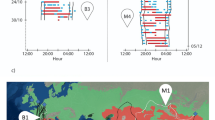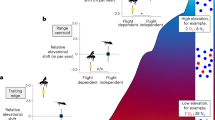Abstract
OBSERVATIONS on mass flights of the migratory grasshopper, Melanoplus bilituratus (Walker) = (M. mexicanus mexicanus (Sauss.)), in 1938–40, indicated that large populations had moved 165–575 miles usually in a downwind direction1. During these prolonged flights the insects travelled 15–30 miles a day at an average speed of about 10–12 m.p.h. The wind during such flights was between 2 and 10 m.p.h.
This is a preview of subscription content, access via your institution
Access options
Subscribe to this journal
Receive 51 print issues and online access
$199.00 per year
only $3.90 per issue
Buy this article
- Purchase on Springer Link
- Instant access to full article PDF
Prices may be subject to local taxes which are calculated during checkout
Similar content being viewed by others
References
Parker, J. R., Newton, R. C., and Shotwell, R. L., U.S. Dept. Agric. Tech. Bull., No. 1109 (1955).
Krogh, A., and Weis-Fogh, T., J. Exp. Biol., 29, 211 (1952).
Haskell, P. T. (personal communication).
Parker, J. R., Moni. Agric. Exp. Sta. Bull., No. 223 (1930).
Author information
Authors and Affiliations
Rights and permissions
About this article
Cite this article
RIEGERT, P. Flight of Grasshoppers in the Laboratory. Nature 194, 1298–1299 (1962). https://doi.org/10.1038/1941298a0
Issue Date:
DOI: https://doi.org/10.1038/1941298a0
This article is cited by
Comments
By submitting a comment you agree to abide by our Terms and Community Guidelines. If you find something abusive or that does not comply with our terms or guidelines please flag it as inappropriate.



